Options
Population Analysis of BN and RB Proof Lincoln and Indian Cents
 WingedLiberty1957
Posts: 2,965 ✭✭✭✭✭
WingedLiberty1957
Posts: 2,965 ✭✭✭✭✭
BASIC INTRODUCTION TO BN, RB, & RD COLOR CLASSES FOR COPPER COINS (FOR LAY-PEOPLE)
Copper coins are typically placed into 1 of 3 color classes when graded by third party grading companies including PCGS. The classes are Brown (BN) meaning the coin has less than 5% original mint fresh copper color, Red-Brown (RB) meaning the coin has between 5% and 95% original mint fresh copper color, and Red (RD) meaning the coin has more than 95% original mint-fresh copper color. Red is further divided into Cameo (CA) and Deep Cameo (DC).
Colorfully-toned copper coins generally fall in the BN and RB categories. Usually the most colorful copper coins are in the BN class (especially proofs). Note that not ALL BN graded copper proofs are colorful, some are simply brown in color. However I would estimate that perhaps 80% to 90% of all the BN graded proofs show some non-standard color if you roll them around under the light. (I did want to note that there can be some very striking non-standard-color in the RB class as well.) For collectors of colorfully toned proof copper coins, the BN color class is typically of most interest since since that is where the most colorful examples tend to congregate. Therefore, I wanted to do some statistics on the BN color class, which includes many of the more "colorful" examples.
A POPULATION ANALYSIS OF BN PROOF LINCOLN CENTS
I wanted to do an analysis of PCGS-graded Proof Lincoln Cent populations in the (generally colorful) Brown (BN) color class, so I started with the PCGS population (census) reports. However the way PCGS presents the information (in tabular (table) form), it makes it difficult to analyze on the fly. So I created 3D bar charts out of the raw numbers. I always always found bar charts one of the best way to analyze characteristics and trends in data. I broke down the Lincoln Cent populations into single year "bars" and then separated them (by color coding) into discrete Era's. Note that I did not extend the chart past 1982, as that is when the U.S.Mint changed the Lincoln cent composition from a 95% copper alloy to copper plated zinc. In any case BN proof Lincolns are extremely rare past 1982 with only 1 recorded in the year 1988.
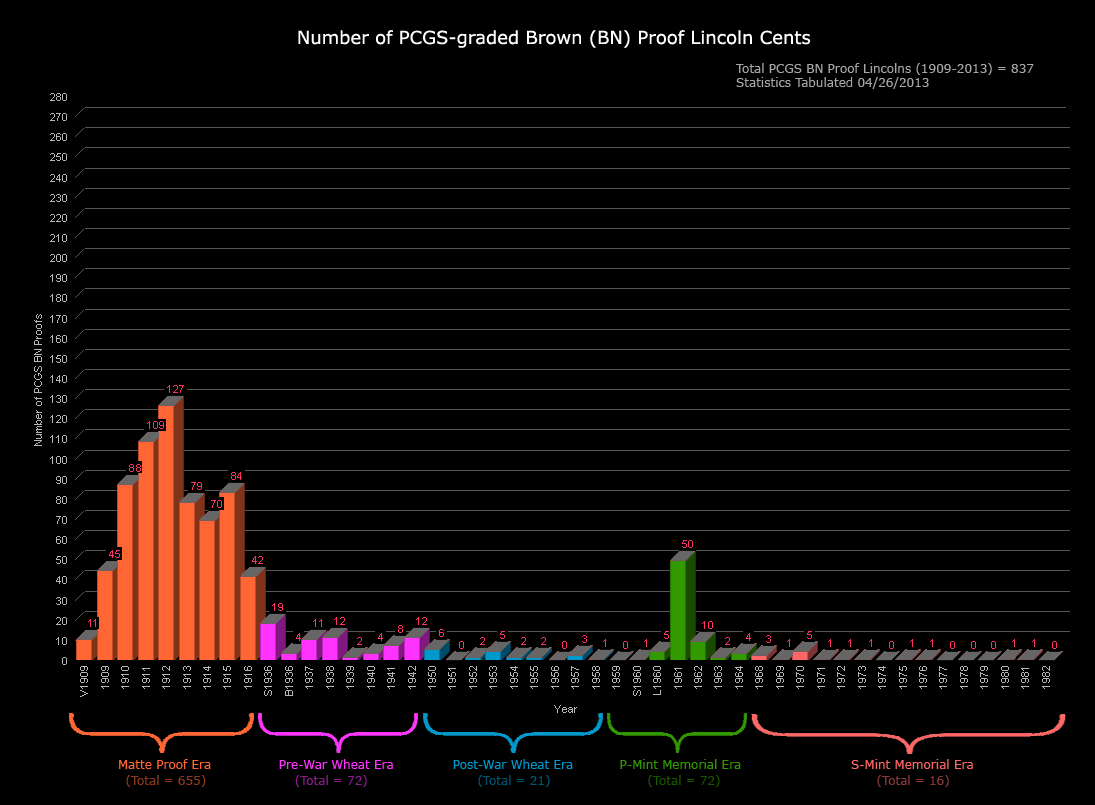
First off, note there are only 837 Total PCGS-graded BN Proof Lincolns for all years (1909-2013). This is actually an amazingly small population -- roughly 1 BN proof in every 1000 proof Lincoln's graded. Approximately 78% of this small population (655 out of 857) of all the PCGS-graded BN Proof Lincolns for the entire series fell in the Matte Proof Lincoln Era (1909-1916). The peak year for BN Proofs was 1912 with 127 slabs cataloged, second place was 1911 with 109 slabs. So even though the Matte Proof Lincolns are the rarest in terms of total population for all color classes and have breathtakingly-small original mintages; they are the most common in the Lincoln Proof Series in the ultra-rare BN color class. The reason for the relatively large population of BN proofs in the Matte Proof Lincoln Era is well-known. The Mint wrapped freshly minted Matte Proof Lincolns in tissue paper and placed them in small envelopes before shipping them out during the years from 1909 through 1916 -- and sulfur in the tissue paper, and probably the envelopes as well, accelerated toning over the years, sometimes producing very beautiful colors on the coins surface.
I did find the “shape of the curve” on the 3D bar chart for Matte Proof Lincolns kind of interesting. BN’s slowly become more and more common going from 1909 to 1912, reaching a peak population in 1912. Then slowly decreased (except for a slight bump up in 1915) going forward to 1916. The shape of that curve almost makes me think that the tissue paper suppliers might have been changing year to year ... or perhaps the sulfur-content of the tissue paper from a single supplier was varying and reached a peak in 1912. Could that be why there are so many beautifully toned Matte Proof Lincolns in 1912, which is one of the best years in the whole Matte Proof Lincoln series for colorful eye-appealing toning.
It's also interesting that if you combine the 1909vdb and 1909 numbers (since they were produced the same year), then 1916 is by far the lowest population year for Proof BNs in the Matte Proof Lincoln run. My guess is that the tissue paper used by the Mint to wrap Matte Proof Lincolns before being shipped out had little sulfur in 1916. That’s why, I think, it’s practically impossible to find colorful 1916 Matte Proof Lincolns amongst the known examples today.
Following the Matte Proof Lincoln Era, there are only 182 PCGS-graded Proof BNs TOTAL in ALL the years that followed, from 1936-2013.
Sticking out like a "sore thumb" on the bar chart is the "monster year" of 1961, which displays an anomalously high population of BN Proofs with a count of 50. So nearly one-third of all the BN Proof Lincolns from 1936–2013 (covering 77 years) are dated 1961 (an interesting statistic). It's also interesting that the 1961 "peak" appears to "drift a bit" into the year 1962, which has a fairly high count of 10 and is the last year the BN Proof count reached double digits. I have heard some theories on why this anomaly exists in 1961, one theory was the U.S.Mint was experimenting with some "rinse solutions" for proofs that year, and one of the rinse solution might have caused accelerated toning. I have no way to know if that is true or not; but I would say this -- I have seen many 1961 monster toned proof Lincoln tone inside unopened and undisturbed mint cello, which tends to eliminate most enviromental factors. Also there is no corresponding toning spike in Business Strike 1961 Lincolns, which eliminates the theory that there could have been trace contaminants in the copper alloy used in 1961. The rinse solution theory is as good of a conjecture as I have heard.
The latest year with a non-trivial number of BNs is 1970 with 5, an anomaly that is probably traced back to the black insert used inside the plastic mint-issued Proof Set that caused or at least accelerated target toning on a number of Lincoln Cents inside the mint-sealed set.
So starting in 1971, BN Proof Lincolns become nearly impossible to find with no more than 1 cataloged in any given year after 1970. The total number of Proof BNs dated after 1970 (through 2013) is only 8, so good luck finding any PCGS Slabbed BN Proof Lincoln's past 1970!
It's interesting to note that there are 37 discrete years with 0 BNs cataloged, most of those years coming after 1976. The earliest year with 0 BNs is 1951. The latest-dated PCGS-graded BN Proof Lincoln is dated 1988, minted 25 years ago.
A POPULATION ANALYSIS OF BN PROOF INDIAN CENTS
Next, I wanted to this same sort of analysis for PCGS graded BN Proof Indian Cents, so I could see the relative populations BN Proof Indian Cents vs. Lincoln Cents. So I made a similar 3D bar chart for Indian Cents. Note that both bar charts for BN Proofs are on the same vertical scale (that is, the top end of both scales is 280 slab counts). So you can compare the heights of the bars between the two charts directly. I broke down the Indian Cent chart into discrete decades (which I color coded).
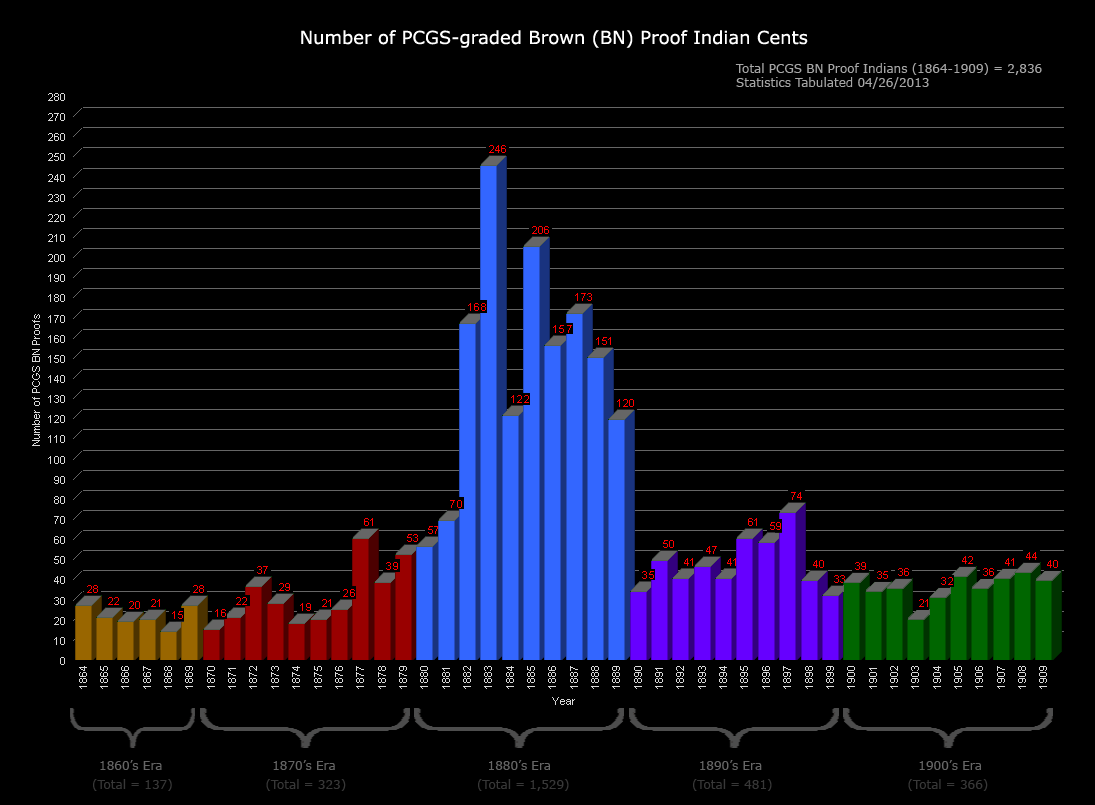
I was interested to note a sizeable spike in the population of Proof BN Indians in the decade of the 1880’s. I always had a sense this 1880’s spike existed because it seemed like every time I saw a stunningly toned BN Proof Indian Cent, it was dated in the 1880’s. I have never heard any theories on why this 1880’s spike occurred, but I wonder if perhaps the U.S. Mint wrapped and mailed Proof Indians during the 1880’s in sulfur-laden tissue paper and/or envelopes like they did in the Matte Proof Lincoln years from 1909-1916 (which corresponds to the other major spike) in Proof BN copper. The 1880’s spike seems statistically significant since over 50% of all Proof BN Indians fall in the decade of the 1880’s. If you total up ALL the Proof BN Indians for ALL the other 36 years of the Indian Cent run, it’s still lower than the population from the 10 years from the 1880’s. And 9 of the 10 years of the 1880’s were at the top of the yearly rankings in terms of population.
The other thing that strikes me about these two 3D bar charts is how much more rare Proof BN Lincolns are vs. Proof BN Indians. There are 2,836 PCGS-graded Proof BN Indians, while there are only 837 PCGS-graded Proof BN Lincolns. And this is with a much larger base population of Proof Lincolns!
There was one other interesting thing that I noticed when preparing these bar charts. I noted that that there are no cataloged PCGS slabbed BN Proof Indians (or Flying Eagle Cents for that matter) prior to 1864. This exactly corresponds to the Copper-Nickel (1859-1864) to Bronze (1864-1909) transition. Note that Copper-Nickel = 88% copper + 12% nickel. While Bronze = 95% copper + 5% tin and zinc. So the Copper-Nickel Indians only have about 7% less copper (88% vs. 95%) than the later Indians (post 1864). I then did a quick search of PCGS Slabbed Indians dated before 1864, and I found that PCGS dropped the BN, RB, or RD color class on the slab label. So clearly PCGS must think that the added nickel content made these earlier Indians and Flying Eagles impossible to classify in the normal BN, RB, RD paradigm. Kind of interesting and something I didn't know (perhaps some of you did).
A POPULATION ANALYSIS OF RB PROOF LINCOLN AND INDIAN CENTS
Since RB Proofs can still show some unusual and striking color, I thought for completeness I would add bar charts for RB Proof Lincolns and Indians.
As expected the total counts are quite a bit higher for RB’s (over BN’s) in general. The total population of PR Indians went from nearly 3000 BN’s to nearly 11,000 RB’s (for a total non-RD count of around 14,000 PR Indians). The total population of PR Lincolns went from around 800 BNs to nearly 5,000 RB’s (for a total non-RD count of around 6,000 PR Lincolns). So there are about 2.5 Toned Proof (BN and RB) Indians for every 1 Toned Proof (BN and RB) Lincoln.
The 1880’s spike in the Proof Indian series is STILL THERE in the RB class, however it’s not as pronounced since the other years show relatively more counts (i.e. Things are smoother and flatter in terms of the population curve)
For the Lincoln Series, there was a marked increase in RB Proofs for the Pre-War Wheat era, a category that actually nosed out the RB Matte Proofs for the Era lead. It might be that the SHEER population (mintage) increase in those 1936-1942 years, overwhelmed the Matte population. Still it’s interesting how few BN’s there are in the Pre-War era.
The 1961 spike is still present in the RB’s, but there is a new spike! The year 1970 took second place amongst all the Lincoln years for total RB counts (due to all those target toned examples) with a slab count of 302, just behind the leader year of 1942 with 331 slabs.
It’s interesting that the full BN’s are still really rare in 1970 as well as 1942! (Two years which were #2 and #1, respectively, for RB slab counts).
The years 1958 and 1959 had a very low count of RB proofs with 7 and 11 respectively. Those two years have the lowest RB slab count prior to 1972 and confirms that 1958 and 1959 are the KEYS to the Toned Proof Lincoln Series prior to 1972 (going all the way back to 1909) … with 1958 being slightly more rare than 1959. It’s amazing that it’s easier to find a colorfully toned 1909 VDB Matte Proof Lincoln in BN (11 slabs) or a RB (76 slabs) than it is to find a toned 1958 Mirror Proof Lincoln in BN (1 slab) or RB (7 slabs) or a 1959 Mirror Proof Lincoln in BN (0 slab) or RB (11 slabs). An amazing fact to consider.
The modern BN and RB Proofs minted after 1972 are very rare. There is only a tiny bump up in 1975 and 1976; after that they get rarer as you move forward in time.
I do realize that I am drawing conclusions from an incomplete population, I probably should add in populations from NGC, however I think there is enough of a sample here to be statistically significant.
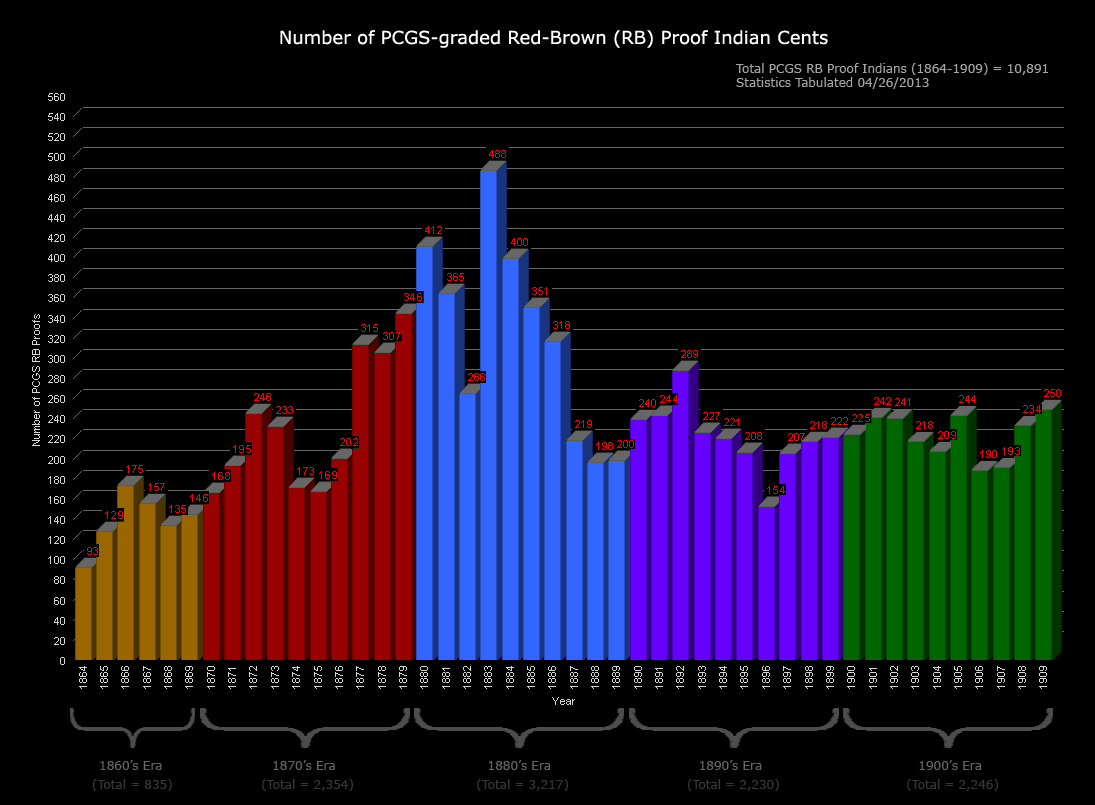
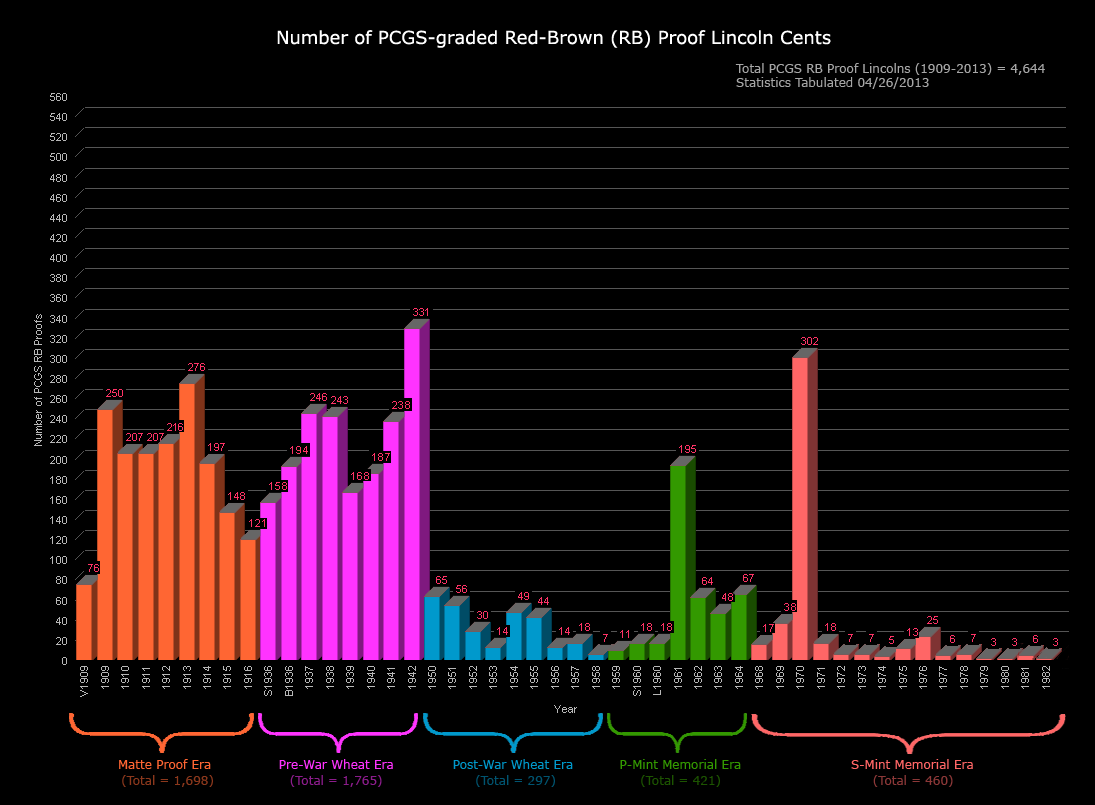
SOME FINAL SUMMARY STATISTICS
Finally, I wanted to take a look at the total counts in all color classes and then look at the relative population in each color class. There are close to 73,000 total PCGS-slabbed Lincoln Proofs but only 17,500 total PCGS-slabbed Indian Proofs. Yet there are about 3.5x more BN Proof Indians as BN Proof Lincolns; and about 2.5x more RB Proof Indians as RB Proof Lincolns. Clearly the BN and RB Proof Lincolns are really quite rare in terms of absolute numbers and percentage of total population. Much rarer than the Proof non-red Indian Cents. In terms of absolute population, the BN and RB Proof Lincolns are 2.5x to 3.5x more rare than the BN and RB Proof Indians. In terms of percentage population of the total, BN and RB Proof Lincolns are 5x to 8x more rare than the BN and RB Proof Indians. What is really interesting (to me at least) about these numbers is the true rarity of BN and RB Proofs in the Lincoln Series is in the Mirror Proof populations (not the Mattes).
Finally I wanted to see what percentage the combined BN and RB class constitute of their total population for each series.
- 78% of all slabbed Proof Indians are BN or RB (The rarity are the RDs!)
- 14% of all slabbed Proof Wheatbacks are BN or RB
- 2% of all slabbed Proof Memorials are BN or RB (The BN percentage was negligible, with only 89 BN examples out of 42,000+ submitted)
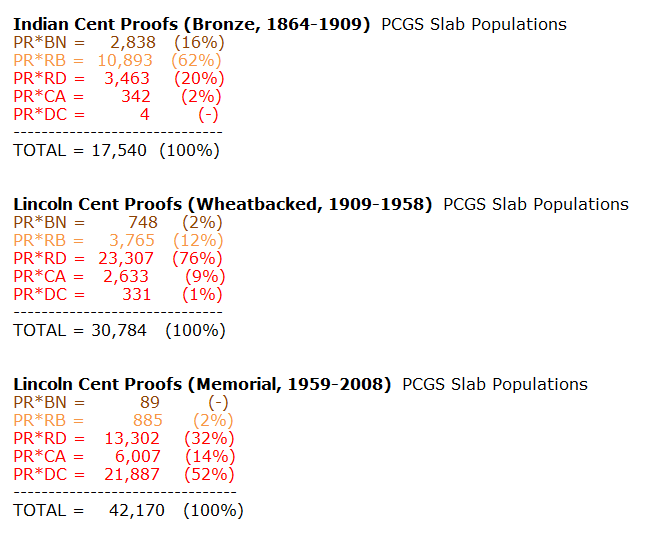
VARIOUS BN PROOF INDIAN AND LINCOLN EXAMPLES
A beautiful Proof Indian (from the collection of Robec) (PR66BN)
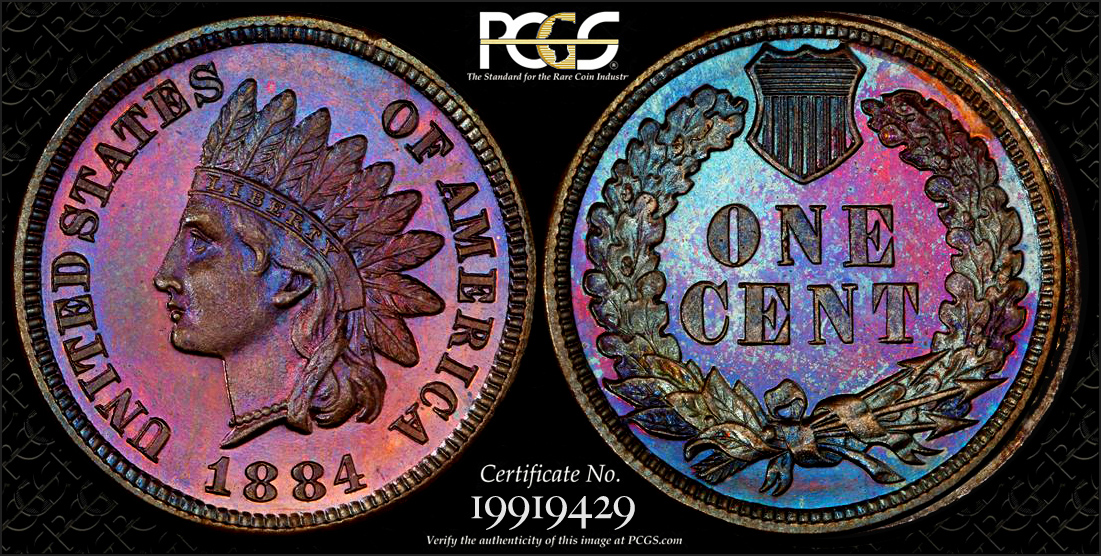
A stunning colorfully toned Matte Proof Lincoln (PR66BN)
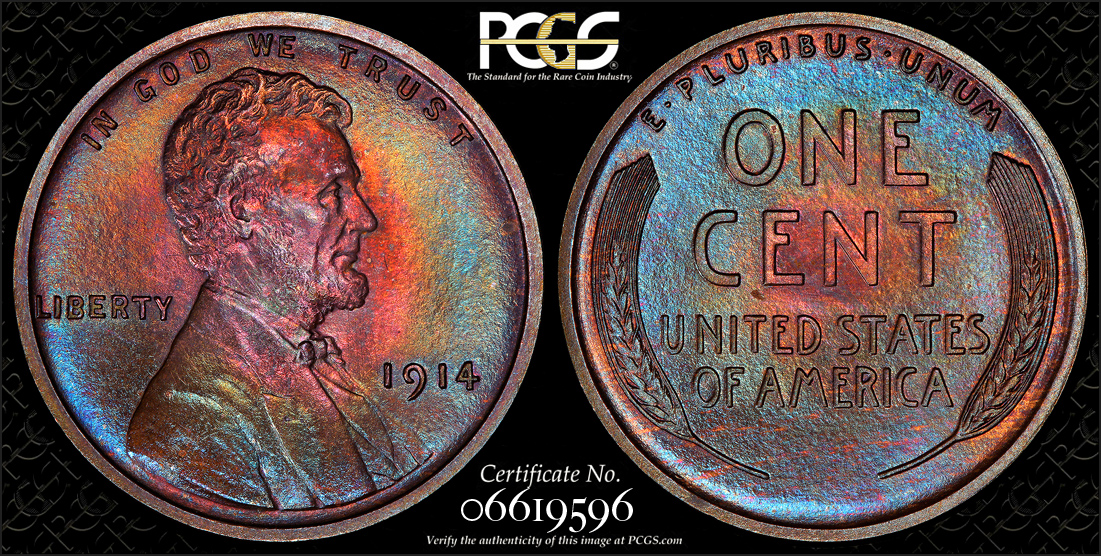
An unusual colorful Pre-War Proof Lincoln (PR64BN)

One of the more striking 1961 Proof Lincolns (PR67BN)

A very rare BN Proof Lincoln from the S-Mint Memorial Era (PR65BN)
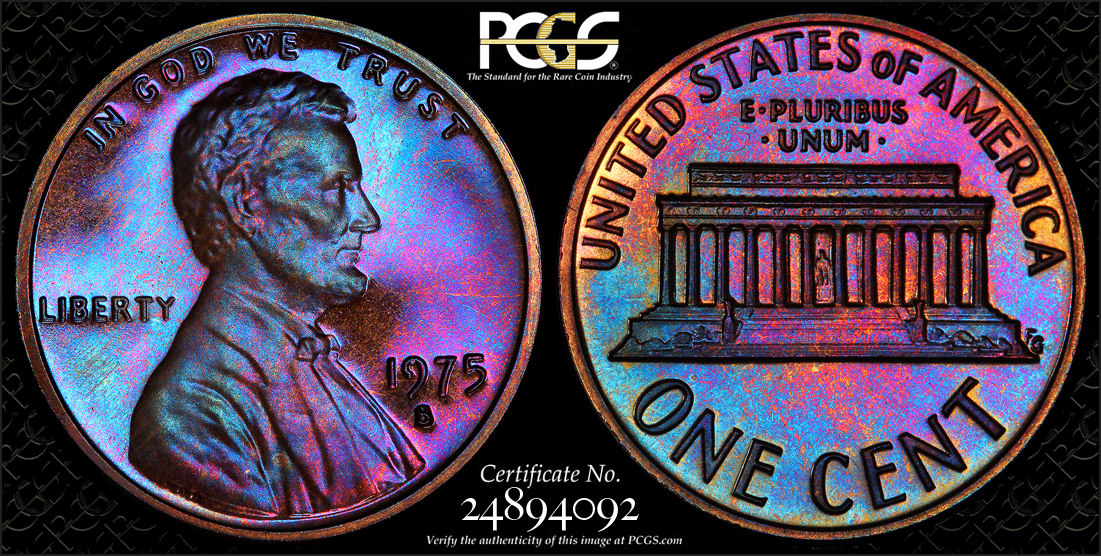
Copper coins are typically placed into 1 of 3 color classes when graded by third party grading companies including PCGS. The classes are Brown (BN) meaning the coin has less than 5% original mint fresh copper color, Red-Brown (RB) meaning the coin has between 5% and 95% original mint fresh copper color, and Red (RD) meaning the coin has more than 95% original mint-fresh copper color. Red is further divided into Cameo (CA) and Deep Cameo (DC).
Colorfully-toned copper coins generally fall in the BN and RB categories. Usually the most colorful copper coins are in the BN class (especially proofs). Note that not ALL BN graded copper proofs are colorful, some are simply brown in color. However I would estimate that perhaps 80% to 90% of all the BN graded proofs show some non-standard color if you roll them around under the light. (I did want to note that there can be some very striking non-standard-color in the RB class as well.) For collectors of colorfully toned proof copper coins, the BN color class is typically of most interest since since that is where the most colorful examples tend to congregate. Therefore, I wanted to do some statistics on the BN color class, which includes many of the more "colorful" examples.
A POPULATION ANALYSIS OF BN PROOF LINCOLN CENTS
I wanted to do an analysis of PCGS-graded Proof Lincoln Cent populations in the (generally colorful) Brown (BN) color class, so I started with the PCGS population (census) reports. However the way PCGS presents the information (in tabular (table) form), it makes it difficult to analyze on the fly. So I created 3D bar charts out of the raw numbers. I always always found bar charts one of the best way to analyze characteristics and trends in data. I broke down the Lincoln Cent populations into single year "bars" and then separated them (by color coding) into discrete Era's. Note that I did not extend the chart past 1982, as that is when the U.S.Mint changed the Lincoln cent composition from a 95% copper alloy to copper plated zinc. In any case BN proof Lincolns are extremely rare past 1982 with only 1 recorded in the year 1988.

First off, note there are only 837 Total PCGS-graded BN Proof Lincolns for all years (1909-2013). This is actually an amazingly small population -- roughly 1 BN proof in every 1000 proof Lincoln's graded. Approximately 78% of this small population (655 out of 857) of all the PCGS-graded BN Proof Lincolns for the entire series fell in the Matte Proof Lincoln Era (1909-1916). The peak year for BN Proofs was 1912 with 127 slabs cataloged, second place was 1911 with 109 slabs. So even though the Matte Proof Lincolns are the rarest in terms of total population for all color classes and have breathtakingly-small original mintages; they are the most common in the Lincoln Proof Series in the ultra-rare BN color class. The reason for the relatively large population of BN proofs in the Matte Proof Lincoln Era is well-known. The Mint wrapped freshly minted Matte Proof Lincolns in tissue paper and placed them in small envelopes before shipping them out during the years from 1909 through 1916 -- and sulfur in the tissue paper, and probably the envelopes as well, accelerated toning over the years, sometimes producing very beautiful colors on the coins surface.
I did find the “shape of the curve” on the 3D bar chart for Matte Proof Lincolns kind of interesting. BN’s slowly become more and more common going from 1909 to 1912, reaching a peak population in 1912. Then slowly decreased (except for a slight bump up in 1915) going forward to 1916. The shape of that curve almost makes me think that the tissue paper suppliers might have been changing year to year ... or perhaps the sulfur-content of the tissue paper from a single supplier was varying and reached a peak in 1912. Could that be why there are so many beautifully toned Matte Proof Lincolns in 1912, which is one of the best years in the whole Matte Proof Lincoln series for colorful eye-appealing toning.
It's also interesting that if you combine the 1909vdb and 1909 numbers (since they were produced the same year), then 1916 is by far the lowest population year for Proof BNs in the Matte Proof Lincoln run. My guess is that the tissue paper used by the Mint to wrap Matte Proof Lincolns before being shipped out had little sulfur in 1916. That’s why, I think, it’s practically impossible to find colorful 1916 Matte Proof Lincolns amongst the known examples today.
Following the Matte Proof Lincoln Era, there are only 182 PCGS-graded Proof BNs TOTAL in ALL the years that followed, from 1936-2013.
Sticking out like a "sore thumb" on the bar chart is the "monster year" of 1961, which displays an anomalously high population of BN Proofs with a count of 50. So nearly one-third of all the BN Proof Lincolns from 1936–2013 (covering 77 years) are dated 1961 (an interesting statistic). It's also interesting that the 1961 "peak" appears to "drift a bit" into the year 1962, which has a fairly high count of 10 and is the last year the BN Proof count reached double digits. I have heard some theories on why this anomaly exists in 1961, one theory was the U.S.Mint was experimenting with some "rinse solutions" for proofs that year, and one of the rinse solution might have caused accelerated toning. I have no way to know if that is true or not; but I would say this -- I have seen many 1961 monster toned proof Lincoln tone inside unopened and undisturbed mint cello, which tends to eliminate most enviromental factors. Also there is no corresponding toning spike in Business Strike 1961 Lincolns, which eliminates the theory that there could have been trace contaminants in the copper alloy used in 1961. The rinse solution theory is as good of a conjecture as I have heard.
The latest year with a non-trivial number of BNs is 1970 with 5, an anomaly that is probably traced back to the black insert used inside the plastic mint-issued Proof Set that caused or at least accelerated target toning on a number of Lincoln Cents inside the mint-sealed set.
So starting in 1971, BN Proof Lincolns become nearly impossible to find with no more than 1 cataloged in any given year after 1970. The total number of Proof BNs dated after 1970 (through 2013) is only 8, so good luck finding any PCGS Slabbed BN Proof Lincoln's past 1970!
It's interesting to note that there are 37 discrete years with 0 BNs cataloged, most of those years coming after 1976. The earliest year with 0 BNs is 1951. The latest-dated PCGS-graded BN Proof Lincoln is dated 1988, minted 25 years ago.
A POPULATION ANALYSIS OF BN PROOF INDIAN CENTS
Next, I wanted to this same sort of analysis for PCGS graded BN Proof Indian Cents, so I could see the relative populations BN Proof Indian Cents vs. Lincoln Cents. So I made a similar 3D bar chart for Indian Cents. Note that both bar charts for BN Proofs are on the same vertical scale (that is, the top end of both scales is 280 slab counts). So you can compare the heights of the bars between the two charts directly. I broke down the Indian Cent chart into discrete decades (which I color coded).

I was interested to note a sizeable spike in the population of Proof BN Indians in the decade of the 1880’s. I always had a sense this 1880’s spike existed because it seemed like every time I saw a stunningly toned BN Proof Indian Cent, it was dated in the 1880’s. I have never heard any theories on why this 1880’s spike occurred, but I wonder if perhaps the U.S. Mint wrapped and mailed Proof Indians during the 1880’s in sulfur-laden tissue paper and/or envelopes like they did in the Matte Proof Lincoln years from 1909-1916 (which corresponds to the other major spike) in Proof BN copper. The 1880’s spike seems statistically significant since over 50% of all Proof BN Indians fall in the decade of the 1880’s. If you total up ALL the Proof BN Indians for ALL the other 36 years of the Indian Cent run, it’s still lower than the population from the 10 years from the 1880’s. And 9 of the 10 years of the 1880’s were at the top of the yearly rankings in terms of population.
The other thing that strikes me about these two 3D bar charts is how much more rare Proof BN Lincolns are vs. Proof BN Indians. There are 2,836 PCGS-graded Proof BN Indians, while there are only 837 PCGS-graded Proof BN Lincolns. And this is with a much larger base population of Proof Lincolns!
There was one other interesting thing that I noticed when preparing these bar charts. I noted that that there are no cataloged PCGS slabbed BN Proof Indians (or Flying Eagle Cents for that matter) prior to 1864. This exactly corresponds to the Copper-Nickel (1859-1864) to Bronze (1864-1909) transition. Note that Copper-Nickel = 88% copper + 12% nickel. While Bronze = 95% copper + 5% tin and zinc. So the Copper-Nickel Indians only have about 7% less copper (88% vs. 95%) than the later Indians (post 1864). I then did a quick search of PCGS Slabbed Indians dated before 1864, and I found that PCGS dropped the BN, RB, or RD color class on the slab label. So clearly PCGS must think that the added nickel content made these earlier Indians and Flying Eagles impossible to classify in the normal BN, RB, RD paradigm. Kind of interesting and something I didn't know (perhaps some of you did).
A POPULATION ANALYSIS OF RB PROOF LINCOLN AND INDIAN CENTS
Since RB Proofs can still show some unusual and striking color, I thought for completeness I would add bar charts for RB Proof Lincolns and Indians.
As expected the total counts are quite a bit higher for RB’s (over BN’s) in general. The total population of PR Indians went from nearly 3000 BN’s to nearly 11,000 RB’s (for a total non-RD count of around 14,000 PR Indians). The total population of PR Lincolns went from around 800 BNs to nearly 5,000 RB’s (for a total non-RD count of around 6,000 PR Lincolns). So there are about 2.5 Toned Proof (BN and RB) Indians for every 1 Toned Proof (BN and RB) Lincoln.
The 1880’s spike in the Proof Indian series is STILL THERE in the RB class, however it’s not as pronounced since the other years show relatively more counts (i.e. Things are smoother and flatter in terms of the population curve)
For the Lincoln Series, there was a marked increase in RB Proofs for the Pre-War Wheat era, a category that actually nosed out the RB Matte Proofs for the Era lead. It might be that the SHEER population (mintage) increase in those 1936-1942 years, overwhelmed the Matte population. Still it’s interesting how few BN’s there are in the Pre-War era.
The 1961 spike is still present in the RB’s, but there is a new spike! The year 1970 took second place amongst all the Lincoln years for total RB counts (due to all those target toned examples) with a slab count of 302, just behind the leader year of 1942 with 331 slabs.
It’s interesting that the full BN’s are still really rare in 1970 as well as 1942! (Two years which were #2 and #1, respectively, for RB slab counts).
The years 1958 and 1959 had a very low count of RB proofs with 7 and 11 respectively. Those two years have the lowest RB slab count prior to 1972 and confirms that 1958 and 1959 are the KEYS to the Toned Proof Lincoln Series prior to 1972 (going all the way back to 1909) … with 1958 being slightly more rare than 1959. It’s amazing that it’s easier to find a colorfully toned 1909 VDB Matte Proof Lincoln in BN (11 slabs) or a RB (76 slabs) than it is to find a toned 1958 Mirror Proof Lincoln in BN (1 slab) or RB (7 slabs) or a 1959 Mirror Proof Lincoln in BN (0 slab) or RB (11 slabs). An amazing fact to consider.
The modern BN and RB Proofs minted after 1972 are very rare. There is only a tiny bump up in 1975 and 1976; after that they get rarer as you move forward in time.
I do realize that I am drawing conclusions from an incomplete population, I probably should add in populations from NGC, however I think there is enough of a sample here to be statistically significant.


SOME FINAL SUMMARY STATISTICS
Finally, I wanted to take a look at the total counts in all color classes and then look at the relative population in each color class. There are close to 73,000 total PCGS-slabbed Lincoln Proofs but only 17,500 total PCGS-slabbed Indian Proofs. Yet there are about 3.5x more BN Proof Indians as BN Proof Lincolns; and about 2.5x more RB Proof Indians as RB Proof Lincolns. Clearly the BN and RB Proof Lincolns are really quite rare in terms of absolute numbers and percentage of total population. Much rarer than the Proof non-red Indian Cents. In terms of absolute population, the BN and RB Proof Lincolns are 2.5x to 3.5x more rare than the BN and RB Proof Indians. In terms of percentage population of the total, BN and RB Proof Lincolns are 5x to 8x more rare than the BN and RB Proof Indians. What is really interesting (to me at least) about these numbers is the true rarity of BN and RB Proofs in the Lincoln Series is in the Mirror Proof populations (not the Mattes).
Finally I wanted to see what percentage the combined BN and RB class constitute of their total population for each series.
- 78% of all slabbed Proof Indians are BN or RB (The rarity are the RDs!)
- 14% of all slabbed Proof Wheatbacks are BN or RB
- 2% of all slabbed Proof Memorials are BN or RB (The BN percentage was negligible, with only 89 BN examples out of 42,000+ submitted)

VARIOUS BN PROOF INDIAN AND LINCOLN EXAMPLES
A beautiful Proof Indian (from the collection of Robec) (PR66BN)

A stunning colorfully toned Matte Proof Lincoln (PR66BN)

An unusual colorful Pre-War Proof Lincoln (PR64BN)

One of the more striking 1961 Proof Lincolns (PR67BN)

A very rare BN Proof Lincoln from the S-Mint Memorial Era (PR65BN)

0
Comments
Good work.
Thank you very much.
"If I say something in the woods and my wife isn't there to hear it.....am I still wrong?"
My Washington Quarter Registry set...in progress
But Great work!!!
WS
I sure wish I knew what the secret that 1961 holds.
- Bob -

MPL's - Lincolns of Color
Central Valley Roosevelts
Hoard the keys.
https://greatcollections.com/Collections/1120/The-Keyman64-Mercury-Dime-Collection/2024-07-07
One question, isn't the fact that probably most if not all of these proof Lincolns from the Memorial Era are still sitting in their proof sets, effectively confounding the results?
<< <i>Wow, that is a heck of a lot of data collection! One question, isn't the fact that probably most if not all of these proof Lincolns from the Memorial Era are still sitting in their proof sets, effectively confounding the results? >>
Yes, most of the population of proof coins, after the flat pack era began (in 1955), is still inside original government packaging (OGP). This has 2 effects: 1.) it reduces the numbers of total proofs graded by PCGS in those eras and 2.) it reduces the effects of toning, since a coin inside mint sealed cello (or hard plastic) is protected (somewhat) from the environment and environmental changes.
People that crack out or cut out Proof coins from OGP (post 1955), and submit them to PCGS, did so for 1 of 2 reasons generally (both profit related). First, in an attempt to get a very high RD, CA, or DC grade which can have great value according to the PCGS price guide. Second, to get PCGS to bless beautiful or unusual toning on coins (to get a Non-Genuine (Non-Questionable Color) grade), which can be sold for huge toning premiums over guide price. Both of these types of modern proof coins can bring hundreds of dollars (colorful PCGS-graded BN's) to sometimes thousands of dollars (very high grade CA's and DC's) in the marketplace.
So the modern proof Lincolns that are cracked out and submitted to PCGS are generally the high grade RDs and the colorful and striking BNs (and sometimes RBs). The plain generic (and extremely common) mid-grade RD Lincolns are not cracked out since they bring no premium, and there is no financial incentive. So millions of these mid-grade RD proof coins sit languishing in their original packaging (and sadly are difficult to sell as intact original proof sets since there is a huge oversupply and little demand).
This fact does not mitigate the fact that gradeable BN Proof Lincolns in the later years are extremely rare. Just go poke through gargantuan piles of OGP Modern Proof Sets at every coin dealer you visit and every coin show you attend (or scan the ebay archives) and see for yourself. The only real exception to this "rarity" rule for BN's in the modern era is in the year 1961 (and sometimes in other early 1960's cello flat packs) where you actually have a shot at finding a gradeable BN Lincoln inside. If you extend to colorful RB Lincolns your best shot in the modern era is in (and around) 1970, where target toning is almost common (in the scheme of things).
My Coin Blog
My Toned Lincoln Registry Set
https://pcgs.com/setregistry/showcase/2819